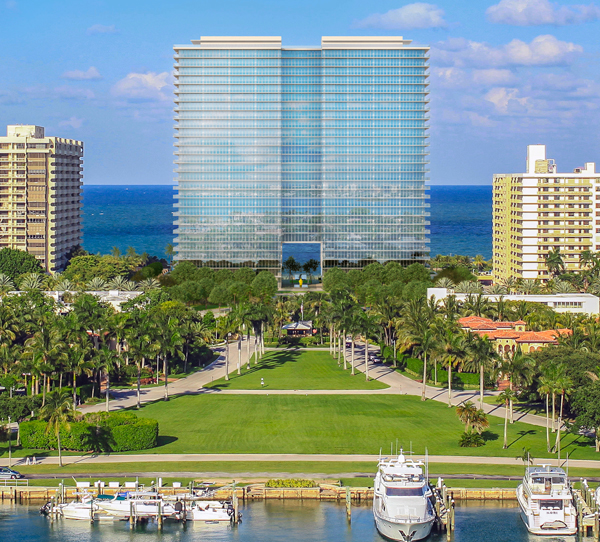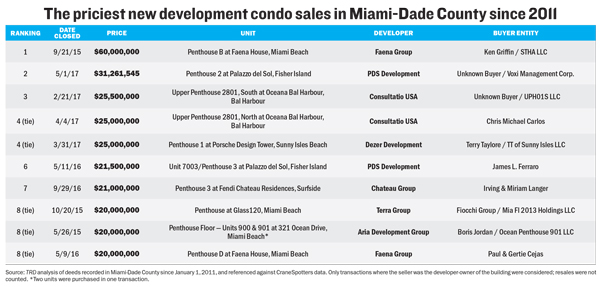Trending
So long to the salad days

The current state of luxury condo development in South Florida is perhaps best illustrated by the trajectory of H3 Hollywood. The development was planned as a 15-story, 247-unit condominium in the city of Hollywood. Then, in September 2016, with 60 percent of its units under contract — and 13 floors built — the developer, Hollywood Station Investments, ran out of money and halted construction while it looked for financing. By the spring, the project was ordered to foreclosure auction, where LB Construction of South Florida — the general contractor on the project — submitted the winning bid. In April, an investor group led by real estate broker Vivian Dimond took over the project. The group spent about $5 million reimbursing buyer deposits and then made the decision to convert H3 to rental apartments.“We are not going to be a condo,” Dimond said in a Sept. 1 interview. “At least not under my ownership.”
While a widely acknowledged downturn in condo development is unfolding, with some developers pivoting to rentals, pricey sales within the last several months highlight the market’s impressive ride to the top of the cycle. A new unit at Palazzo del Sol on Fisher Island, which sold for about $31.3 million, commanded the highest price paid for a condo in South Florida since 2015, when hedge funder Ken Griffin paid $60 million for a penthouse at Miami Beach’s Faena House, according to research by The Real Deal.
To rank the priciest sales in Miami-Dade this cycle, TRD analyzed deeds recorded in the county since January 1, 2011, and referenced those against data from CraneSpotters, a database that tracks all new condo developments that have filed plans since 2011. By comparing the sales against the CraneSpotters list of developer entities, TRD was able to rank only new development sales. Resales were not counted.
The analysis found that four of the top 10 priciest sales took place this year; however, many industry insiders say the sky-high prices herald the approach of a cyclical South Florida downturn, while others go further and argue that despite these deals, the region’s luxury market has been in a slump for some time.
Data from CraneSpotters.com shows that 11,860 South Florida condos were under construction in August, down from 13,467 at the end of last year.
“Roughly half of what is going to be delivered in this cycle is still under construction,” said CraneSpotters.com founder Peter Zalewski. “The deliveries are building up. You’re probably going to see most of it come online in the next 12 to 18 months.”
Beyond that, Zalewski said he expects the decline to just get worse: “We’re in the first year of the downturn … And in 2019, we’ll probably hit bottom. In ’20 or ’21, we’ll probably start building again.”
Dodge Data & Analytics recently reported that the value of condominiums and other Miami-area multifamily housing projects that advanced to the construction phase dropped 43 percent in the first half of the year from the same period last year.

But condominium developments commonly take two years and often longer to sell and build. So, if a long-term decline in condo construction has started in South Florida, its full impact won’t be felt for a while. “We’re still doing [condo] deals. We’re doing deals every day,” said Daniel de la Vega, the Coral Gables-based president of One Sotheby’s International Realty. This year, for example, he helped to broker the sale of a penthouse at the Oceana Bal Harbour condominium for $25 million, which ranked among the 10 priciest condo sales in TRD’s ranking.
Still, some precautions have been taken this time around. Before the last downturn, which began over a decade ago, deposits of only 10 percent were common. In recent years, many condo developers in the Miami-Dade market have required deposits of up to 50 percent of unit prices, reducing their need to borrow or raise money.
Even with relatively little financial leverage, however, the number of condo projects failing to advance beyond the preconstruction phase is mounting. CraneSpotters.com reported in August that developers had revised, suspended or canceled a total of 8,832 condo units in South Florida since 2011, up from 7,785 shelved units at the end of 2016.
Few condo project cancellations in South Florida attracted more attention than this year’s shutdown of the Related Group’s 60-story Auberge Residences & Spa Miami. It may have been a milestone in South Florida’s condo development cycle. Related had presold about 15 percent of the units planned for the site at 1440 Biscayne Boulevard before it canceled the project and returned buyers’ deposits.
The developer is now waiting before launching more condo projects in Brickell and other areas in Miami’s urban core, said Carlos Rosso, president of Related’s condo development division.
The firm has already launched Wynwood 29, a condo project in Miami’s Wynwood neighborhood, which is “finally getting an influx of high-end luxury property to address pent-up demand,” Rosso said in an email exchange.
“We also have projects in other neighborhoods like Brickell [in Miami], where prices have leveled off, and we are waiting for some inventory absorption before launching projects like 444 Brickell,” Rosso said, referring to a riverfront location where Related has planned a phased development with a hotel, office space and 1,200 residential units.
Rosso added that borrowing to build condos in South Florida has become more difficult, preventing developers with limited experience from putting more units on the market: “Construction financing has been tightening for the past few years, but this is by no means a negative trend … It ensures only the best projects get off the ground.”
Anthony Graziano, Miami-based senior managing director of research and advisory firm Integra Realty Resources, agreed that “it’s going to be harder to get a project out of the ground over the next 12 to 18 months.”
Graziano said many banks returned to South Florida’s condo construction loan market during the 2013-2014 period, “but they were coming in almost as mezzanine debt … Their overall exposure to the project was 30 or 40 percent [of its value], max.” In the last 24 months, however, “their exposure increased, and certain lenders just started to fall out of the market,” he said.
As condo construction grinds on, a buyer’s market has developed in Miami’s condo resale market, Graziano said, citing a growing number of units listed for sale and a shrinking pool of buyers. “Resale prices are declining. Last year, it was about 6 to 8 percent,” he said. “This year, because of the amount of inventory, we’ll probably see another 4 to 6 percent decline in overall pricing.”
Much of the downward pressure on overall condo pricing appears to come from the high end of the market. Research by Integra Realty shows that 95 condos in Miami-Dade are listed for sale at or above $10 million, and at the current pace of sales, fewer than 10 condos a year are selling in that lofty price range.
“The run rate on condos over $10 million is about eight or nine a year. So, there’s a lot more elasticity in that pricing,” Graziano said. “If I’ve got a $20 million condo, and you come to me and offer $16 million for it, I have to think about it.”
Many Latin Americans bought newly built condos in Miami before the overall pace of development slowed last year. “You have some buildings where it was 100 percent sold to Venezuelans, or 100 percent sold to Brazilians,” said Jack McCabe of McCabe Research & Consulting in Deerfield Beach.
“It was flight capital, getting money out of their home countries and converting it into U.S. dollars,” McCabe said. “In their own countries, the political and economic turmoil was such that they were afraid of losing it.”
Now, some developers are afraid of losing that influx of flight capital as President Donald Trump promises to crack down on illegal immigration and the Treasury Department intensifies its scrutiny of large cash purchases of South Florida condos and other real estate.
The Treasury Department’s Financial Crimes Enforcement Network (FinCEN) announced in August that it will broaden an anti-money laundering program to identify suspicious transactions involving luxury real estate.
Under a revised geographic targeting order, wire transfers are now subject to Treasury regulations that require title insurance companies to disclose the identity of buyers who purchase luxury real estate through limited liability corporations (LLCs). The revised order — which covers property deals in South Florida, New York City, California and Texas — also was extended to transactions in Honolulu, Hawaii.
“I believe they wouldn’t have done that unless they were finding a lot. You wouldn’t put that much money and resources into it if all you had found was a dead end,” McCabe said. But “we probably won’t see the results from this investigation for two or three years.”
By then, he believes, South Florida’s condo production will have peaked and receded. “We’re in the middle of the ninth inning, to use a baseball analogy,” McCabe said. “We’re already seeing price drops. We’re seeing developers offering to pay real estate salespeople 8 and 10 percent commissions to find buyers.”
— Harunobu Coryne provided research for this article.





